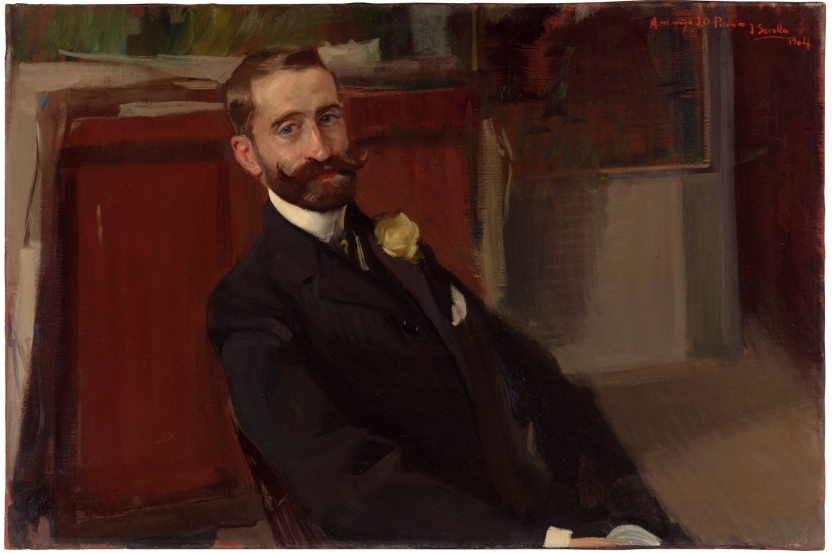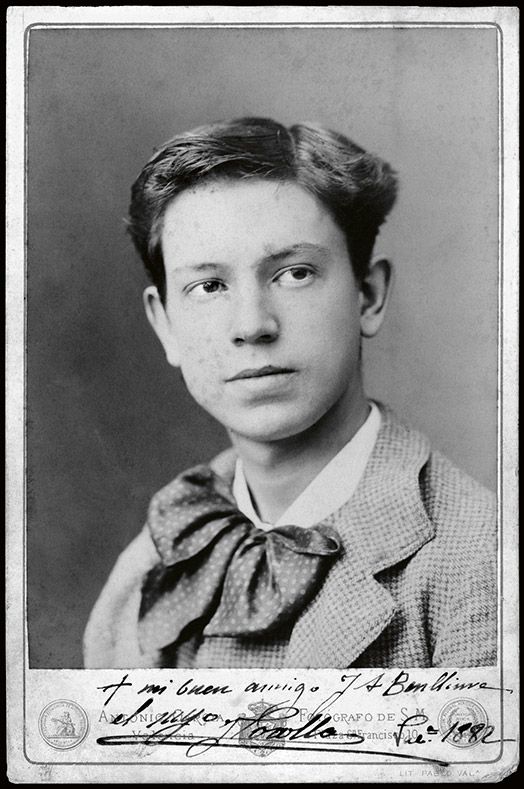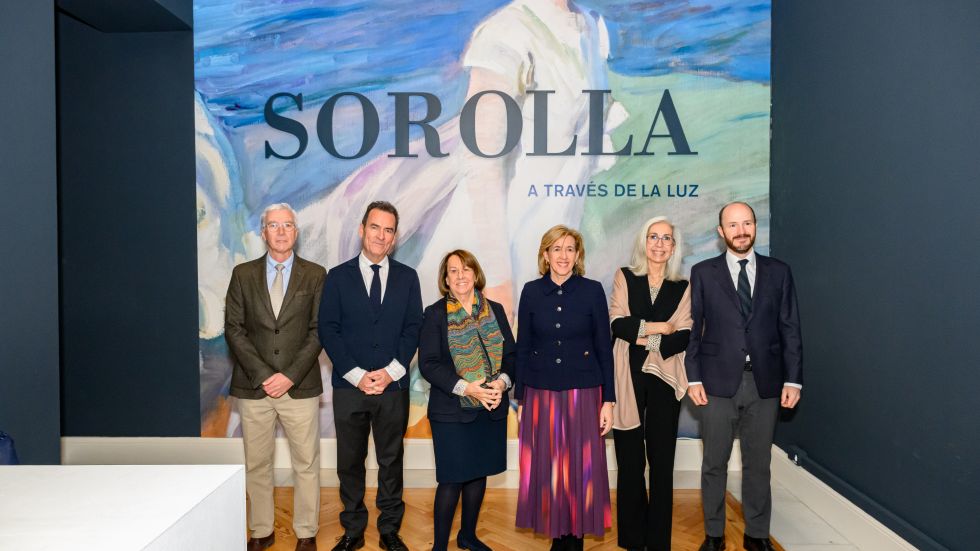1863
Joaquín Sorolla y Bastida nace en Valencia el 27 de febrero. A la edad de dos años queda huérfano y es acogido por sus tíos. Joaquín Sorolla y Bastida
1876-1878 Formación en Valencia
Asiste a clases de dibujo en la Escuela de Artesanos de Valencia, y posteriormente ingresa en la Escuela de Bellas Artes. Allí conoce a Tono García del Castillo, con quien entabla amistad. El padre de este, el fotógrafo Antonio García Peris, se convertirá en mecenas de Sorolla durante algunos años, y con su hija Clotilde iniciará el pintor una relación de noviazgo.
1881-1887 Madrid, Roma, París
Sorolla empieza a ver mundo. En 1881 visita el Museo del Prado y queda profundamente impresionado por la pintura de Velázquez. En 1884, su cuadro El grito del Palleter es premiado por la Diputación de Valencia con una pensión para estudiar en Roma. Entra en contacto con la colonia de artistas españoles, trabaja y visita museos. Allí conoce a Pedro Gil Moreno de Mora, que será un gran amigo toda su vida. Este lo invita a su casa de París, donde Sorolla permanece seis meses, trabajando intensamente y visitando museos y exposiciones. Le impresionan particularmente las obras de los pintores naturalistas Adolf von Menzel y Jules Bastien-Lepage. Desde esa primera visita, Sorolla regresará con frecuencia a París para conocer las novedades artísticas.

1888-1890 Matrimonio y tiempos difíciles
Sorolla regresa a Valencia y se casa con Clotilde. Vuelven juntos a Italia y residen algún tiempo en Asís. Allí pinta buscando en el realismo su «camino verdadero» mientras se mantiene a duras penas con la venta de cuadritos y acuarelas. En 1889 la pareja viaja a París para visitar la Exposición Universal, y Sorolla queda muy impresionado por los pintores nórdicos Peder Severin Krøyer y Anders Zorn. Se establecen definitivamente en Madrid. En 1890 nace su primera hija: María.
1891-1898 Familia, trabajo y realismo social
En 1892 nace el segundo hijo, Joaquín, y en 1895, Elena. Sorolla es ya un responsable padre de familia; participa regularmente en exposiciones en España y el extranjero y empieza a recibir premios y encargos relevantes. Seguro ya de su estilo, produce obras ambiciosas en la órbita del realismo social, que tienen una excelente acogida en las exposiciones: en 1893 pinta ¡Otra Margarita!, que se vende en Estados Unidos; y en 1894 ¡Aún dicen que el pescado es caro!, Trata de blancas y La vuelta de la pesca, que es adquirida por el Estado francés. Este ciclo termina con Triste herencia, de 1899.
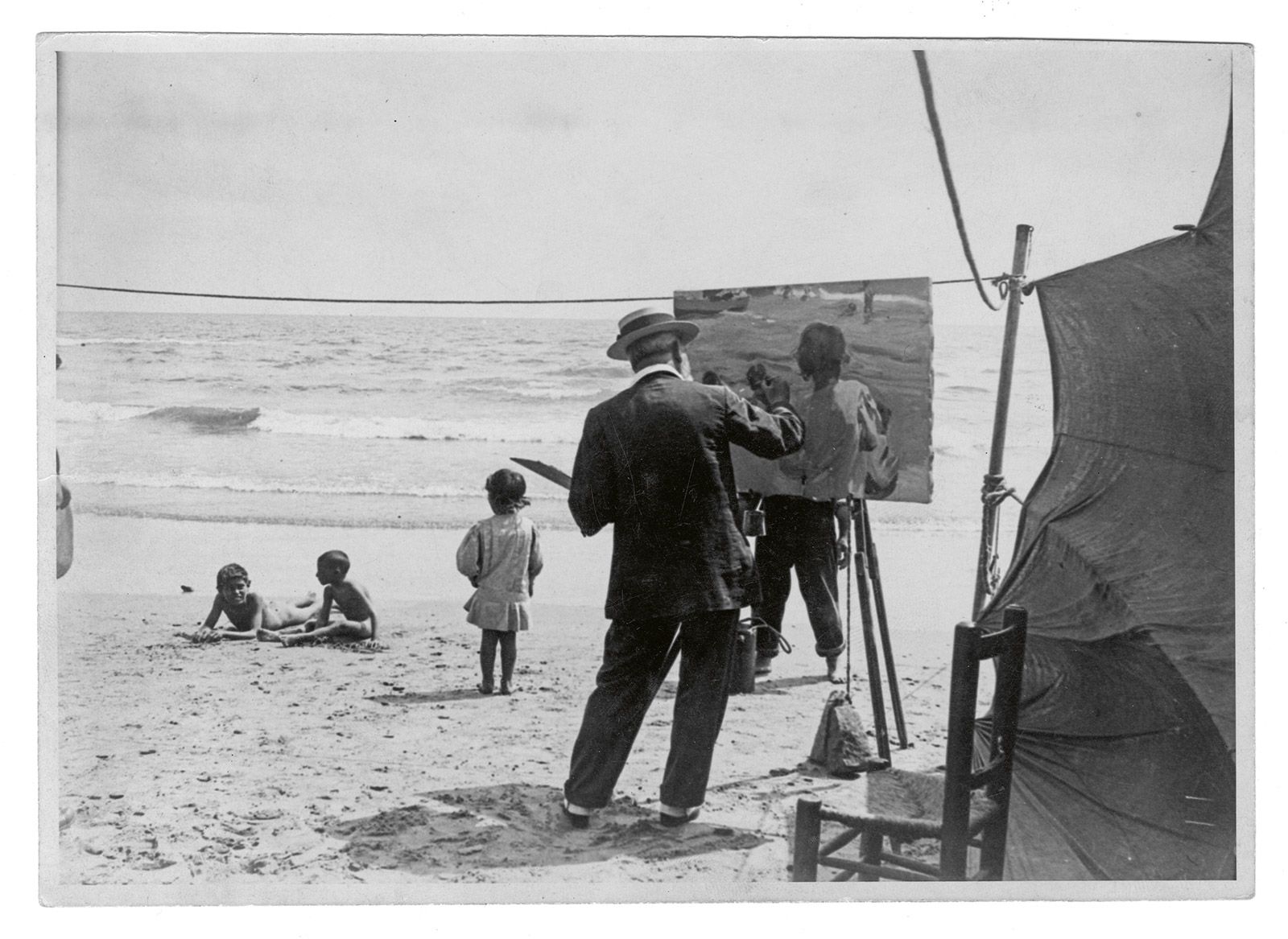
1900-1903 El camino del éxito
En 1900 recibe el Grand Prix de la Exposición Universal de París por el conjunto de su producción, pero en particular por Triste herencia. Allí conoce personalmente a importantes pintores como Giovanni Boldini, John Singer Sargent o Anders Zorn. En 1901 consigue la Medalla de Honor en la Exposición Nacional de Bellas Artes de Madrid. Clotilde le acompaña fielmente en todas sus etapas. En estos años Sorolla le dedica dos preciosos homenajes: Madre, donde la representa en la cama junto a su hija Elena recién nacida, y Desnudo de mujer, una obra íntima llena de sensualidad. Pinta regularmente en la playa de Valencia. Junto a los cuadros de tema social, desarrolla una nueva línea de escenas de la vida de los pescadores, vistas con una mirada optimista que saca el máximo partido de la belleza del mar y la alegría del sol. La inicia en gran formato con Cosiendo la vela (1896), que también se expuso en París en 1900, y tiene un hito en Sol de la tarde (1903), en el que el propio Sorolla vio el inicio de su madurez artística.
1904-1905 Luz, color
En 1904 pinta cerca de 250 cuadros, algunos tan emblemáticos como Verano, y a finales de ese año se traslada a un nuevo domicilio, una casa con estudio y un gran jardín. Su trabajo se centra cada vez más en el estudio de la luz y el color. Las sucesivas estancias en el pequeño puerto alicantino de Jávea (en 1896, 1898, 1900 y 1905) le revelan un mar de aguas profundas y cristalinas, distinto del de la playa de Valencia, y le familiarizan con un colorido más intenso y brillante y con efectos nuevos de luces y reflejos. Fin de jornada, de 1900, es ya un manifiesto de esa nueva sensibilidad. En la estancia de 1905, Sorolla estudia las transparencias de los cuerpos sumergidos y produce obras maestras como El bote blanco.
1906 Primera exposición individual: París
En el mes de julio celebra su primera gran exposición individual en París, en la Galerie Georges Petit, una de las más prestigiosas. Presenta 450 cuadros, y obtiene un éxito clamoroso. La crítica se deshace en elogios y las ventas confirman la excelente acogida de su pintura. Pasa el verano en Biarritz, donde pinta otro tipo de playa, con un colorido fresco y limpio: la playa de los veraneantes a la moda, que disfrutan el aire marino vestidos de punta en blanco. El otoño lo dedica en Segovia y Toledo a la pintura de paisaje, que irá cobrando importancia en su producción. Su hija María contrae una grave tuberculosis y la familia se traslada a una casa en los montes de El Pardo.
1907 Exposiciones en Alemania y descanso en La Granja
En 1907 Sorolla envía una exposición de 280 obras a Berlín, Düsseldorf y Colonia. Él no puede acudir a causa de la enfermedad de su hija. En verano, y con María ya repuesta, la familia se traslada a La Granja de San Ildefonso, donde Sorolla pinta en los jardines aprovechando el atractivo de la luz filtrada entre los árboles para hacer retratos al aire libre, entre ellos el extraordinario Retrato del rey Alfonso XIII con uniforme de húsar.

1908 Exposición en Londres
En febrero pinta en los jardines del Alcázar de Sevilla. Las Grafton Galleries de Londres acogen, de mayo a junio, una exposición de 450 obras de Sorolla, una muestra que cuenta con importantes patrocinadores y que es inaugurada con gran ceremonia. Allí se vendió un retrato de Manuel B. Cossío, destacado intelectual de la Institución Libre de Enseñanza y autor de la primera gran monografía que se escribió sobre el Greco. Sorolla, muy amigo del escritor y admirador de su obra, volvió a pintarlo inmediatamente en un retrato de extrema sobriedad y elegancia que trasluce la inteligencia y sensibilidad del modelo. Sorolla aprovecha su estancia para visitar museos, y en el Británico disfruta intensamente con las esculturas de Fidias para el Partenón de Atenas. Cuando regresa a España, con el recuerdo fresco de las esculturas griegas, pinta en Valencia escenas de playa donde los adolescentes que disfrutan del agua y el sol evocan el sueño de una feliz humanidad «mediterránea», gozadora de los dones de la naturaleza.
1909 Nueva York. La gran aventura americana
El filántropo hispanista Archer Milton Huntington, fundador de la Hispanic Society of America, invita a Sorolla a realizar una gran exposición en su nuevo edificio de Nueva York. Esta se inaugura en febrero con un éxito delirante: en un mes la visitan 160.000 personas, la crítica es unánimemente elogiosa y las ventas son cuantiosas. La exposición, algo reducida, se presenta después en la Copley Society de Boston y en la Fine Arts Academy de Búfalo. Sorolla regresa a España definitivamente rico y famoso. Su estancia de ese verano en Valencia es una de las más productivas; a esa temporada pertenecen algunos de sus cuadros de playa más famosos, como Paseo a orillas del mar o El baño del caballo.
1910 Retratos y jardines
1910 es una añada de excelentes retratos familiares: Clotilde sentada en un sofá, Clotilde en traje de noche, María con blusa roja o Elena con sombrero negro. En estancias anteriores en Andalucía (1908 y 1909), Sorolla había pintado en la Alhambra de Granada y el Alcázar de Sevilla. Le atraen los jardines andaluces con su mezcla de vegetación, arquitectura y agua. Ahora, en 1910, vuelve a pintar en ambos lugares: los jardines ocuparán cada vez más espacio en su pintura y su pensamiento.
1911 Una nueva casa
La Hispanic Society organiza exposiciones de Sorolla en el Art Institute de Chicago y en el City Art Museum de San Luis. La familia pasa el verano en San Sebastián, donde Sorolla pinta uno de sus cuadros más originales: La siesta. En diciembre se traslada a la nueva casa que se ha hecho construir en el entonces llamado Paseo del Obelisco, hoy General Martínez Campos, un palacete para el que el propio Sorolla diseñará y plantará un hermoso jardín inspirándose en motivos de la Alhambra de Granada y el Alcázar de Sevilla que tanto le habían impresionado. Firma el contrato con Huntington para decorar la biblioteca de la Hispanic Society con una serie de escenas de los tipos y costumbres de las distintas regiones españolas: La visión de España.
1912-1914 La visión de España
Sorolla emprende los trabajos para la decoración, que se compone de un conjunto de grandes lienzos, a veces unidos entre sí para formar paneles mayores; estas tareas le ocuparán intensamente hasta 1919. Viajará por todo el país haciendo estudios del natural para ejecutar los paneles, que en ocasiones pintará íntegramente in situ, al aire libre. Empieza por el gran panel de Castilla, que será el mayor de la serie. En los veranos cambia de escenario y se traslada a San Sebastián, donde descansa y pinta. El estallido de la Guerra Mundial detiene la celebración de exposiciones. Sorolla no vuelve a viajar al extranjero.
1915-1916 Y siempre, la playa de Valencia
En estos dos años, mientras viaja incansablemente por España para realizar los paneles, Sorolla pasa los veranos en Valencia, donde pinta monumentales escenas de playa, como Pescadoras valencianas o La bata rosa, con un tratamiento de la luz cada vez más sabio, más maduro.
1917-1918 Más viajes
En 1917 y 1918 pinta de nuevo y por última vez en la Alhambra y el Alcázar. Sigue viajando para continuar con la elaboración de La visión de España. Después de Valencia, las grupas (1916) y Extremadura, el mercado (1917), pinta Elche, el palmeral, que resplandece de luz dorada.
1919 Finales
Termina La visión de España. Sin acusar cansancio o decadencia, lleva a cabo una de sus mejores escenas: Ayamonte, la pesca del atún, la última de todas y uno de los espectáculos de luz más hermosos que Sorolla pintó nunca. En Mallorca e Ibiza realiza sus últimos cuadros de playa, y todavía, en Los contrabandistas, nos sorprende con audaces perspectivas y un azul aún más limpio, más intenso. El jardín de su casa ha crecido ya lo suficiente para ser pintado, y Sorolla disfruta haciéndolo.
1920-1923 El pintor en su jardín
En 1920 Sorolla solo tiene 57 años, pero su aspecto es el de un anciano: los últimos años de duro trabajo en La visión de España han quebrantado su salud. Para entonces ha recibido ya todas las medallas, honores y aplausos a los que puede aspirar un artista; es famoso, respetado, rico y adorado por su familia y sus amigos. Ahora descansa pintando su jardín y algún retrato allí mismo, bajo los árboles. En el mes de junio de 1920, mientras hace un retrato bajo la pérgola, sufre una hemiplejia. No volverá a pintar. Vivirá todavía tres años, mimado por su familia, pero ya ajeno a cuanto le rodea. Muere en agosto de 1923. Su entierro en Valencia es un acontecimiento multitudinario: Sorolla estaba en el cénit de su popularidad.
1926 La visión de España se instala en la Hispanic Society
En 1922 se habían trasladado a Nueva York los paneles de La visión de España. La biblioteca de la Hispanic Society, con los paneles de Sorolla ya por fin instalados, queda abierta al público.
1929-1932 El museo de Sorolla
Clotilde muere en 1929 y lega al Estado español la casa familiar y su colección de pintura de Sorolla para que se haga un museo. La creación del Museo atraviesa un periodo convulso de la historia de España: el final del reinado de Alfonso XIII y la proclamación de la Segunda República. Sin embargo, estas circunstancias no detuvieron el proyecto: el legado fue aceptado en 1931 y el Museo se abrió en 1932.





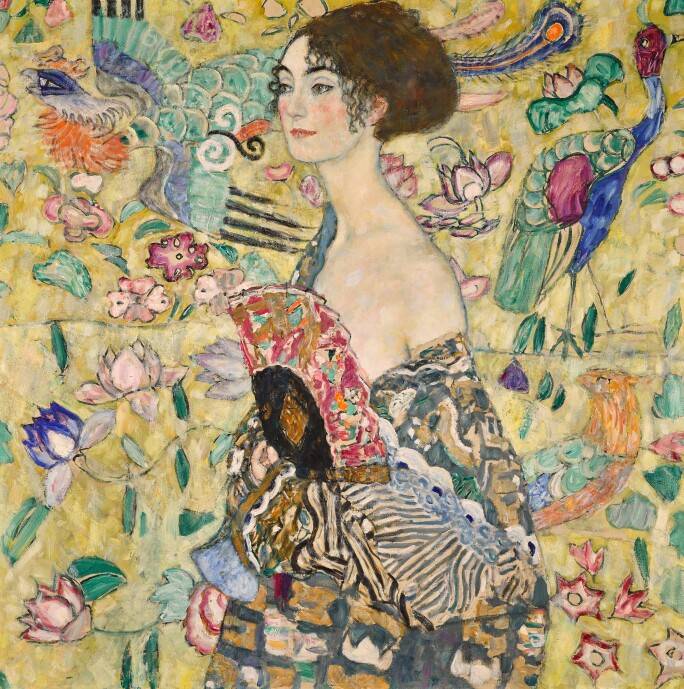
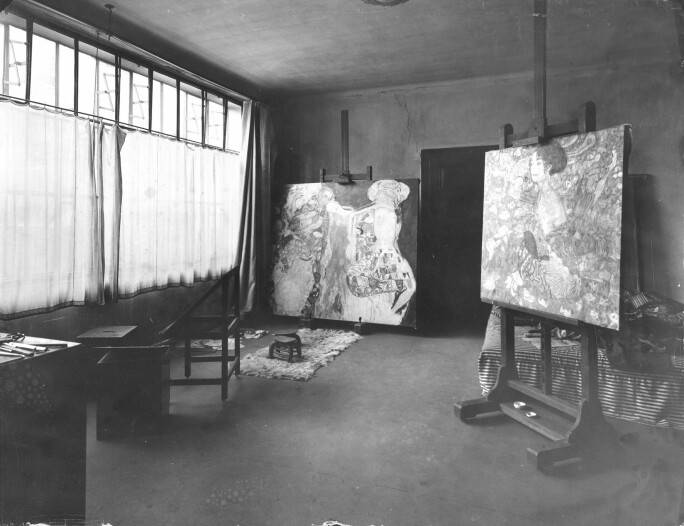










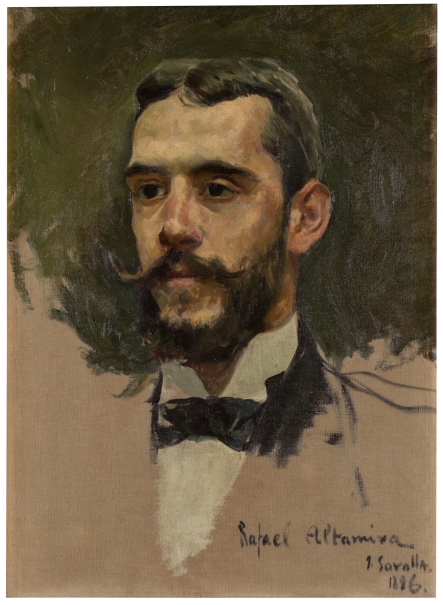
 3
3
